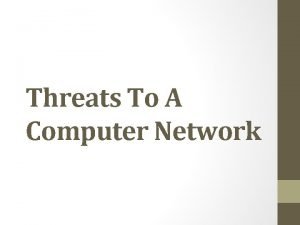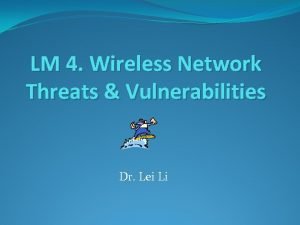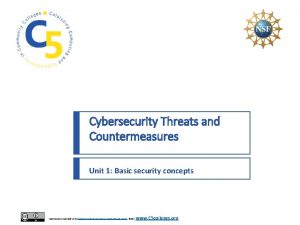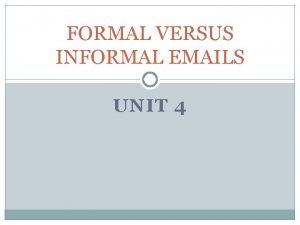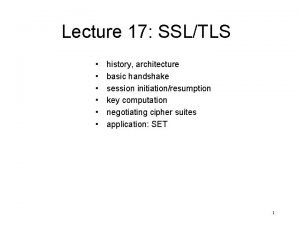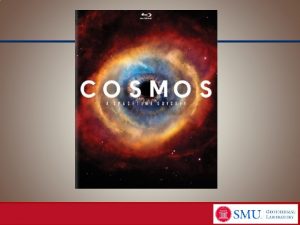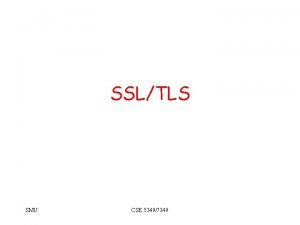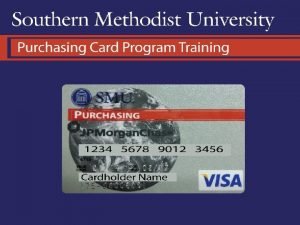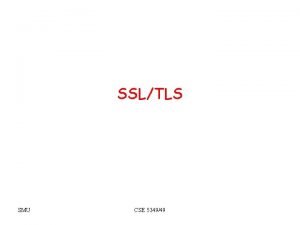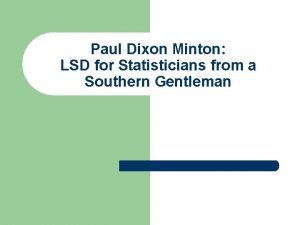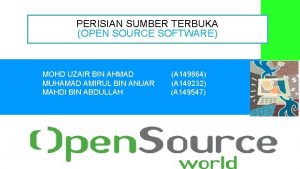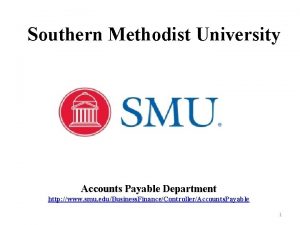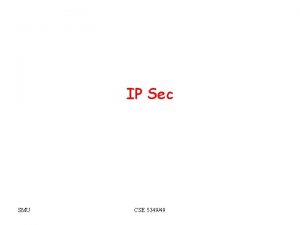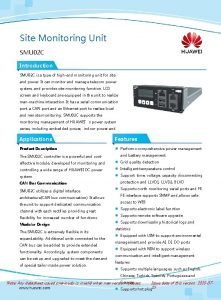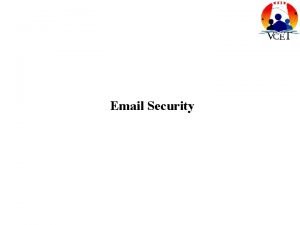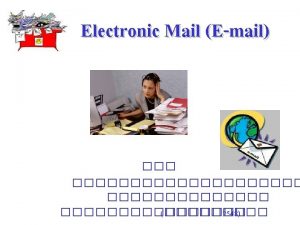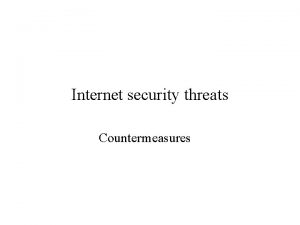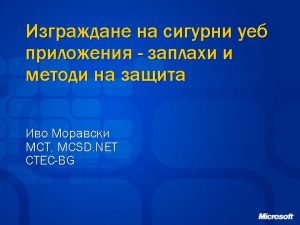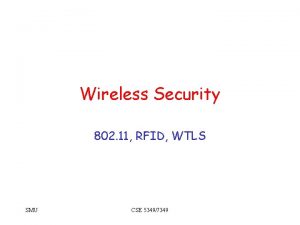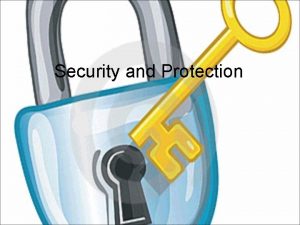Email Security SMU CSE 534949 Threats Threats to




















- Slides: 20

Email Security SMU CSE 5349/49

Threats • Threats to the security of e-mail itself – Loss of confidentiality • E-mails are sent in clear over open networks • E-mails stored on potentially insecure clients and mail servers – Loss of integrity • No integrity protection on e-mails; body can be altered in transit or on mail server – Lack of data origin authentication – Lack of non-repudiation – Lack of notification of receipt SMU CSE 5349/7349

Threats Enabled by E-mail • • Disclosure of sensitive information Exposure of systems to malicious code Denial-of-Service (Do. S) Unauthorized accesses etc. SMU CSE 5349/7349

What are the Options • Secure the server to client connections (easy thing first) – – POP, IMAP over ssh, SSL https access to webmail Very easy to configure Protection against insecure wireless access • Secure the end-to-end email delivery – The PGPs of the world – Still need to get the other party to be PGP aware – Practical in an enterprise intra-network environment SMU CSE 5349/7349

Email based Attacks • Active content attack – Clean up at the server (AV, Defang) • Buffer over-flow attack – Fix the code • Shell script attack – Scan before send to the shell • Trojan Horse Attack – Use “do not automatically use the macro” option • Web bugs (for tracking) – Mangle the image at the mail server SMU CSE 5349/7349

Email SPAM • Cost to exceed $10 billion • SPAM filtering – – SMU Content based – required hits White list Black list Defang MIME CSE 5349/7349

PGP • • PGP=“Pretty Good Privacy” First released in 1991, developed by Phil Zimmerman Freeware: Open. PGP and variants: Open. PGP specified in RFC 2440 and defined by IETF Open. PGP working group. – www. ietf. org/html. charters/openpgp-charter. html • Available as plug-in for popular e-mail clients, can also be used as stand-alone software. SMU CSE 5349/7349

PGP • Functionality – Encryption for confidentiality. – Signature for non-repudiation/authenticity. • Sign before encrypt, so signatures on unencrypted data - can be detached and stored separately. • PGP-processed data is base 64 encoded SMU CSE 5349/7349

PGP Algorithms Broad range of algorithms supported: • Symmetric encryption: – DES, 3 DES, AES and others. • Public key encryption of session keys: – RSA or El. Gamal. • Hashing: – SHA-1, MD-5 and others. • Signature: – RSA, DSS, ECDSA and others. SMU CSE 5349/7349

PGP Services SMU CSE 5349/7349

PGP Message SMU CSE 5349/7349

PGP Key Rings • PGP supports multiple public/private keys pairs per sender/recipient. • Keys stored locally in a PGP Key Ring – essentially a database of keys. • Private keys stored in encrypted form; decryption key determined by user-entered pass-phrase. SMU CSE 5349/7349

Key Management for PGP • Public keys for encrypting session keys / verifying signatures. • Private keys for decrypting session keys / creating signatures. • Where do these keys come from and on what basis can they be trusted? SMU CSE 5349/7349

PGP Key Management • PGP adopts a trust model called the web of trust. • No centralised authority • Individuals sign one another’s public keys, these “certificates” are stored along with keys in key rings. • PGP computes a trust level for each public key in key ring. • Users interpret trust level for themselves. SMU CSE 5349/7349

PGP Trust Levels • Trust levels for public keys dependent on: – Number of signatures on the key; – Trust level assigned to each of those signatures. • Trust levels recomputed from time to time. SMU CSE 5349/7349

PGP Key Mgmt Issues • Original intention was that all e-mail users would contribute to web of trust. • Reality is that this web is sparsely populated. • How should security-unaware users assign and interpret trust levels? • Later versions of PGP support X. 509 certs. SMU CSE 5349/7349

PGP Message Generation SMU CSE 5349/7349

PGP Message Generation (cont’d) • The sending PGP entity performs the following steps: – Signs the message: • PGP gets sender’s private key from key ring using its user id as an index. • PGP prompts user for passphrase to decrypt private key. • PGP constructs the signature component of the message. – Encrypts the message: • PGP generates a session key and encrypts the message. • PGP retrieves the receiver public key from the key ring using its user id as an index. • PGP constructs session component of message SMU CSE 5349/7349

PGP Message Reception SMU CSE 5349/7349

PGP Message Reception • The receiving PGP entity performs the following steps: – Decrypting the message: • PGP get private key from private-key ring using Key ID field in session key component of message as an index. • PGP prompts user for passphrase to decrypt private key. • PGP recovers the session key and decrypts the message. – Authenticating the message: • PGP retrieves the sender’s public key from the public-key ring using the Key ID field in the signature key component as index. • PGP recovers the transmitted message digest. • PGP computes the message for the received message and compares it to the transmitted version for authentication. SMU CSE 5349/7349
 Privat security
Privat security Computer network threats
Computer network threats Ccna security chapter 1
Ccna security chapter 1 Ecommerce security threats
Ecommerce security threats Wireless security threats and vulnerabilities
Wireless security threats and vulnerabilities Wireless security threats
Wireless security threats Cyber security threats and countermeasures
Cyber security threats and countermeasures Formal informal email
Formal informal email Handshake
Handshake Dsa major
Dsa major Smu student senate
Smu student senate Carnivourous
Carnivourous Smu geothermal
Smu geothermal Smu handshake
Smu handshake Smu purchasing
Smu purchasing Smu handshake
Smu handshake Smu actuarial science
Smu actuarial science Paul dixon smu
Paul dixon smu Perisian smu
Perisian smu Smu accounts payable
Smu accounts payable Smu notebook tender
Smu notebook tender

